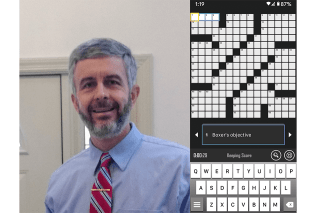Professor publishes a series of crossword puzzles
Bloomsburg
Posted
Mathematical and digital sciences professor Kevin Ferland created 10 crossword puzzles for app.

BLOOMSBURG—Bloomsburg University mathematical and digital sciences professor Kevin Ferland recently published a series of crossword puzzles as an extension on his work on combinatorics, the study of how to count things.
Ferland published his first puzzle in an academic journal in 2014 in which he set out to discover the greatest number of words that can fit into a standard New York Times 15x15 puzzle grid.
The answer: 96, too many to qualify for publication in the Times.
“I tried to publish my 96-word puzzle in the New York Times, but Will Shortz, the editor of the crossword puzzle, said it had too many words. He only allows at most 78, so my 96 was unacceptable, though mathematically interesting,” said Ferland. He decided to publish his puzzle in his math paper instead, but continues to work on puzzles to submit to the New York Times.
Ferland became interested in the combinatorics of crossword puzzles by solving crossword puzzle books. His favorites were created by Shortz. “In one of those books he often referenced the number of words that were in the puzzle solution grid, and he mentioned the record for the fewest number of words ever published,” said Ferland. “This got me interested in the mathematical questions of the greatest and fewest possible number of words in a crossword puzzle.” These questions can be answered with combinatorics.
“Combinatorics is a fancy mathematical term that means many things,” said Ferland. “Typically, it refers to counting possible solutions.” To illustrate, Ferland used the example of poker hands. “How many different hands are there? What is the probability of getting a particular hand? How many ways are there to achieve a particular hand? What is the structure of different sets of five cards that achieve a particular hand? If you are going to gamble on poker, you want to know the answers to these questions.” Using combinatorics, you can figure out the answers to each of these questions.
Even once you understand the math behind how a crossword puzzle works, constructing one can take a long time. “It takes a long time to write a puzzle,” said Ferland, “I can’t guess how many hours for each, but I would say that I work on each for about a month or so of focused effort.”
During the 2020 pandemic, Ferland discovered the Redstone Crossword app and inquired about submitting some puzzles. The developers were impressed with his work and invited him to submit some. Ferland then faced the overwhelming task: creating 10 puzzles for publication on the Redstone Crossword app. The whole construction process took about six months.
Anyone interested in solving Ferland’s puzzles can find them on the Redstone Crossword app under K. Ferland in the medium difficulty category.



